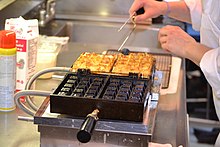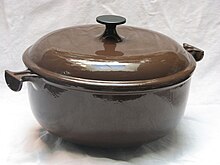| Revision as of 13:41, 25 September 2012 edit69.157.225.132 (talk)No edit summary← Previous edit | Revision as of 18:01, 26 September 2012 edit undo69.157.225.132 (talk) →HistoryNext edit → | ||
| Line 7: | Line 7: | ||
| ==History== | ==History== | ||
| ] | ] | ||
| ] | |||
| Bare cast-iron vessels have been used for cooking for hundreds of years.<ref>{{Cite journal |first=John |last=Ragsdale |title=The Dutch Oven Chronicled 1–4 |year=1991}}</ref> Cast iron ]s and cooking pots were treasured as kitchen items for their durability and their ability to retain heat, thus improving the quality of cooking meals. Before the introduction of the ] in the middle of the 19th century, meals were cooked in the ] or ], and cooking pots and pans were designed for use in the hearth. This meant that all cooking vessels had to be designed to be suspended on, or in, a fireplace. Cast iron pots were made with handles to allow them to be hung over a fire, or with legs so that they could stand up in the fireplace. In addition to ]s, which were developed with the onset of the ], a commonly used cast iron cooking pan called a spider had a handle and three legs used to stand up in the coals and ashes of the fire. Cooking pots and pans with legless, flat bottoms were designed when cooking stoves became popular; this period of the late 19th century saw the introduction of the flat cast iron ]. | Bare cast-iron vessels have been used for cooking for hundreds of years.<ref>{{Cite journal |first=John |last=Ragsdale |title=The Dutch Oven Chronicled 1–4 |year=1991}}</ref> Cast iron ]s and cooking pots were treasured as kitchen items for their durability and their ability to retain heat, thus improving the quality of cooking meals. Before the introduction of the ] in the middle of the 19th century, meals were cooked in the ] or ], and cooking pots and pans were designed for use in the hearth. This meant that all cooking vessels had to be designed to be suspended on, or in, a fireplace. Cast iron pots were made with handles to allow them to be hung over a fire, or with legs so that they could stand up in the fireplace. In addition to ]s, which were developed with the onset of the ], a commonly used cast iron cooking pan called a spider had a handle and three legs used to stand up in the coals and ashes of the fire. Cooking pots and pans with legless, flat bottoms were designed when cooking stoves became popular; this period of the late 19th century saw the introduction of the flat cast iron ]. | ||
Revision as of 18:01, 26 September 2012

Cast iron cookware has excellent heat retention properties and can be produced and formed with a relatively low level of technology. Seasoning is used to protect bare cast iron from rust and to create a non-stick surface.
Types of bare cast-iron cookware include panini presses, waffle irons, crepe makers, dutch ovens, frying pans, deep fryers, tetsubin, woks, potjies, karahi, flattop grills and griddles.
History


Bare cast-iron vessels have been used for cooking for hundreds of years. Cast iron cauldrons and cooking pots were treasured as kitchen items for their durability and their ability to retain heat, thus improving the quality of cooking meals. Before the introduction of the kitchen stove in the middle of the 19th century, meals were cooked in the hearth or fireplace, and cooking pots and pans were designed for use in the hearth. This meant that all cooking vessels had to be designed to be suspended on, or in, a fireplace. Cast iron pots were made with handles to allow them to be hung over a fire, or with legs so that they could stand up in the fireplace. In addition to dutch ovens, which were developed with the onset of the Industrial Revolution, a commonly used cast iron cooking pan called a spider had a handle and three legs used to stand up in the coals and ashes of the fire. Cooking pots and pans with legless, flat bottoms were designed when cooking stoves became popular; this period of the late 19th century saw the introduction of the flat cast iron skillet.
Cast iron cookware was especially popular among homemakers and housekeepers during the first half of the 20th century. Most American households had at least one cast iron cooking pan, and such brands as Griswold and Wagner Ware were especially popular. Although both of these companies folded in the late 1950s and the brands are now owned by the American Culinary Corporation, Wagner and Griswold cast iron pots and pans from this era continue to see daily use among many households in the present day; they are also highly sought after by antique collectors and dealers. The Lodge Manufacturing company is currently the only major manufacturer of cast iron cookware in the United States, as most other cookware suppliers use pots and pans made in Asia or Europe.
The 20th century also saw the introduction and popularization of enamel-coated cast iron cookware.
Cast iron fell out of favor in the 1960s and 1970s, as teflon-coated non-stick cookware was introduced to the public and quickly became the item of choice in many kitchens. Today, a large selection of cookware can be purchased from kitchen suppliers, of which cast iron comprises only a small fraction. However, the durability and reliability of cast iron as a cooking tool has ensured its survival, and cast iron cookware is still recommended by most cooks and chefs as an essential part of any kitchen.
Bare cast iron
Cast iron's ability to withstand and maintain very high cooking temperatures makes it a common choice for searing or frying, and its excellent heat diffusion and retention makes it a good option for long-cooking stews or braised dishes. Because cast iron skillets can develop a "non-stick" surface, they are also a good choice for egg dishes, particularly scrambled eggs. Other uses of cast iron pans include baking, for instance for making cornbread, cobblers and cakes.
Most bare cast iron pots and pans are cast from a single piece of metal in order to provide even distribution of heat. This quality allows most bare cast iron pans to serve as dual-purpose stovetop fryers and oven baking dishes. Many recipes call for the use of a cast iron skillet or pot, especially so that the dish can be initially seared or fried on the stovetop then transferred into the oven, pan and all, to finish baking. Likewise, cast iron skillets can double as baking dishes. Cornbread in particular is seen as a food item that is best prepared in a cast iron skillet: the iron pan is heated beforehand in the oven, the ingredients are combined in the heated pan, and the dish is then placed directly into the oven for fast baking. This differs from many other cooking pots, which have varying components that may be damaged by the excessive temperatures of 400 °F (204 °C) or more.
Cast iron is a very slow conductor of heat and forms hot spots if heated too quickly, or on an undersized burner; however, it has excellent heat retention properties, and the entire pan will eventually become extremely hot, including the iron handle or handles.
Health effects
Cast iron cookware leaches small amounts of iron into the food, a few milligrams per dish. Anemics, and those with iron deficiencies, may benefit from this effect, though those with excess iron issues (for example, people with hemochromatosis) may suffer negative effects.
Seasoning
A seasoned pan has a stick-resistant coating created by polymerized oils and fats. Seasoning is a process by which a layer of animal fat or vegetable oil is applied and cooked onto cast iron or carbon steel cookware. The seasoning layer protects the cookware from rusting, provides a non-stick surface for cooking, and prevents food from interacting with the iron of the pan. Enamel-coated cast iron pans do not need seasoning, as the enamel coating prevents rust in most instances. Television chef Alton Brown advocates re-seasoning cast-iron cookware yearly to ensure a non-stick surface and to protect the surface from rust.
Cleaning

Because ordinary cookware cleaning techniques like scouring or washing in a dishwasher can remove or damage the seasoning on a bare cast iron pan, these pans should not be cleaned like most other cookware. Some cast iron aficionados advocate never cleaning cast iron pans at all, simply wiping them out after use, or washing them with hot water and a stiff brush. Others advocate washing with mild soap and water, and then re-applying a thin layer of fat or oil. A third approach, advocated by television chef Alton Brown, is to scrub with coarse salt and a paper towel or clean rag.
Brands
There are many producers of traditional cast iron in France, Italy, Denmark, Sweden and the UK, manufacturing enamelled and unenamelled cookware. In Asia, particularly China, India, Korea and Japan, there is a long history of cooking with cast iron. Well-established brands in the United States include Griswold and Wagner (now both owned and manufactured by the American Culinary Corporation), Camp Chef, Lodge and John Wright.
Enameled cast iron
| This article includes a list of general references, but it lacks sufficient corresponding inline citations. Please help to improve this article by introducing more precise citations. (April 2010) (Learn how and when to remove this message) |

Enameled cast iron is cast iron that has a vitreous enamel glaze. The enamel coating over the cast iron prevents rusting, eliminates the need to season the metal, and allows for more thorough cleaning. Furthermore, pigments used in the enameling process can produce vibrant colors. While enamel coated cast iron doesn't have the seasoning and cleaning issues of bare cast iron, it can be several times more costly, and does not have some of the benefits of bare cast iron, such as the ability to withstand searing heat and resist sticking. It limits the leaching of dietary iron, and chipping of the enamel coating can be an issue.
Manufacturers of enameled cast iron cookware include Cousances, Le Creuset, Le Chasseur, Lodge, Staub, Descoware, and John Wright. Several newer brands are associated with well-known celebrities and chefs, including Daniel Boulud Kitchen, Martha Stewart, Rachael Ray Cookware (made by Anolon), and Mario Batali (made by Copco).
See also
- Cast iron
- Cookware and bakeware
- List of cast iron cookware manufacturers
- Non-stick surface
- Non-stick pan
References
- Ragsdale, John (1991). "The Dutch Oven Chronicled 1–4".
{{cite journal}}: Cite journal requires|journal=(help) - "Heavy Metal: the Science of Cast Iron Cooking".
- "Cooking with Cast-Iron?". Retrieved December 30, 2007.
- "Techniques for Restoring an old Cast-Iron Skillet". Retrieved December 30, 2007.
- ^ "YouTube: Good Eats Episode 1 Pt.2 "Steak Your Claim"".
- "Caring for your Lodge cast iron cookware". Retrieved November 22, 2009.
- "Using and Caring For Your Cast-Iron Skillet". Retrieved February 29, 2008.
- Andrew Weil MD (March 21, 2006). "Cooking with Cast-Iron?". DrWeil.com. Retrieved January 25, 2011.
External links
| This article's use of external links may not follow Misplaced Pages's policies or guidelines. Please improve this article by removing excessive or inappropriate external links, and converting useful links where appropriate into footnote references. (April 2010) (Learn how and when to remove this message) |
- American Culinary Corporation
- Wagner Mfg. division of American Culinary Corporation
- Learn about cast iron pans from What's Cooking America
- The Wagner and Griswold Society page
- Cast iron skillet use and care
- How It's Made: Cast Iron Cook Ware